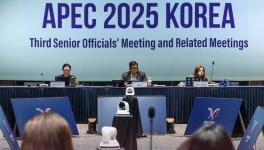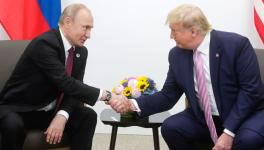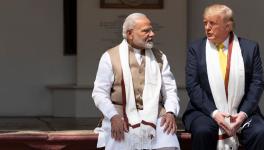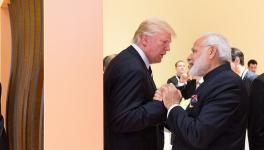The US First Strike Doctrine And the Threat of Nuclear War
EVERY year, August 6 and August 9 are remembered for the horrific nuclear attacks on Hiroshima and Nagasaki. The stick like figures drawn from memory by little children depicting the horrors they saw as they marched through their devastated cities still haunt us. In a matter of moments, 2,40,000 were killed and wounded, most of the wounded dying painfully from radiation sickness, cancers and other diseases soon after.
This is what launched the nuclear disarmament movement and “Never Again” remains the most powerful cry of the all peace loving people.
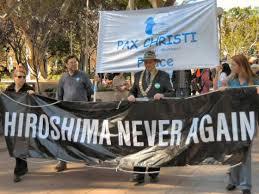
Image Courtesy: flickr.com
The cold war and nuclear competition saw major nuclear powers – the US and Soviet Union – amass nearly 60,000 warheads and brought the world close to extinction. The nuclear forces were always on hair trigger alert and even a small incident or a wrong decision would have rapidly escalated to nuclear strikes and counter strikes, wiping out all life on this planet. Even a limited exchange would have seen a nuclear winter and the end of all human civilisation. This was the nuclear theories of MAD – or mutual assured destruction – and this living on the edge of annihilation was what supposedly preserved nuclear peace.
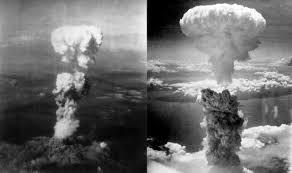
Image Courtesy: commons.wikimedia.org
In the entire cold war period, the US always believed that a first strike option was crucial as it would have lost a land war in Europe. The need for nuclear escalation, even if the other side was using convention weapons, was central to its military doctrine.
We might be pardoned for thinking that with the cold war being officially over, the danger of nuclear weapons is no longer a major threat to the world. The US however does not think so and continues not only with its nuclear doctrines of first strike but has extended it now to nuclear primacy. In simple terms, it now believes it has got the capability to wipe out the nuclear forces of the other side – the two key ones being Russia and China – and catch the retaliatory strike with its anti-ballistic missiles (ABMs). Its nuclear doctrine not only contains the belief that it can win a nuclear war against Russia and China, but also contains propositions that US can use a nuclear strike against countries that may have chemical and biological weapons in a pre-emptive attack.
If we look at what the US has done since the collapse of Soviet Union, the grand design of the US to have position of nuclear primacy – the only power that can wage a nuclear war and win without much damage – becomes clear. The steps it has taken after 1991 are:
- To withdraw from the ABM treaty
- Build missile shields in Czech Republic, Romania and Alaska
- Locate four Aegis missile defence destroyers in Rota, Spain
- Extend NATO to Russia's neighbours even after Russia dismantled the Warsaw pact
A similar encirclement of China is also under way.
Why was the ABM treaty so important? Before the ABM treaty, the nuclear calculations were that any first strike would result in most of a country's nuclear arsenal being destroyed. Therefore, to preserve a credible retaliatory strike, the number of weapons had to be much larger than required for a strike on the enemy. This would ensure that a country striking first would still face a devastating counter strike from the country that it had attacked. It is this need to have enough retaliatory strike capacity that continuously pushed up the arsenals of the US and the Soviet Union. In this numbers game, it dawned on the policy makers that ABM's would push up the need for even more weapons, as a retaliatory strike could be thinned out by such defensive missile shields. It is this realisation that ABM's would push up the already bloated arsenals of the nuclear powers even more that led to the ABM treaty being signed and the decision taken to scale down the nuclear warheads. This was the start of the SALT negotiations and the START agreements. The new START agreement has a target of scaling down the nuclear warheads of the two countries – the US and Russia – to 1,550 by 2018. The attempts by the US to establish nuclear primacy through higher accuracy of its missiles, pinpointing targets and ABM shield therefore threatens the entire structure of even limited nuclear disarmament that the two countries have taken.
Other nuclear weapon countries have much smaller warheads. The three NPT designated nuclear weapon countries – China, UK and France – have 250, 225 and 300 respectively. The other nuclear powers, Israel is estimated to have 80, Pakistan between 100 and 120, and India between 90 and 100. North Korea has probably around 10 or less warheads. The official position of other nuclear weapon countries is that they will join in the nuclear disarmament discussions once the arsenals of the two major countries are comparable to theirs.
China has a theory of credible minimum deterrence. Unlike the US, both Russia and China have always declared that they will not use nuclear weapons unless attacked with nuclear weapons first.
The US had withdrawn from the ABM treaty with the arguments that there were “rogue” states and rogue non-state players demanding the development of a missile shield. Initially, they had also argued that the missile shield being deployed was against Iran. Russia had asked the US that if the shield was for other countries and not Russia, Russia was willing to join the US in creating such a shield. The US has spurned all such advances and its deployment in locations where the country being targeted is obviously Russia makes it clear that the ABM shield is central to its doctrine of nuclear primacy.
Lest we believe that this talk of nuclear primacy is just some anti US posturing, it is instructive to see what the latest US doctrine is. The Nuclear Weapons Employment Policy submitted by the Obama administration on June 13, 2013 makes it clear that the principle of “counterforce” is retained as the central principle in employing nuclear weapons as also the ability to Launch Under Attack. Each of them are continuance of the cold war policies and means that the key elements of nuclear war still remains. Counterforce means that weapons are kept at high levels of alert, ready to launch upon warning of an enemy attack, and able to pre-emptively attack enemy forces. Both elements – pre-emptive nuclear strikes and hair trigger alert of nuclear forces means that the threat of nuclear war remains. With the added policy of ABM shields, the temptation of the US to target other nuclear weapon states or states such as Iran actually increases.
The US has not only argued that it can use pre-emptive nuclear strikes against non-nuclear weapon states, but recently has also argued that even a cyber attack on the US could trigger a nuclear response.
It is clear today that while the US is arguing that nuclear weapons are unacceptable in the arsenal of other countries, it regards the same nuclear weapons not as deterrence but as first strike and pre-emptive weapons. It wants the world to do what it says and not what it does. The hypocrisy involved in these postures is what is unravelling the nuclear compact in which nuclear weapon states agreed to disarm while others agreed to forego nuclear weapons.
It is time we put back nuclear disarmament on the global agenda without which we are entering even more dangerous times. It is time we remembered again the lesson of Hiroshima and Nagasaki.
Disclaimer: The views expressed here are the author's personal views, and do not necessarily represent the views of Newsclick
Get the latest reports & analysis with people's perspective on Protests, movements & deep analytical videos, discussions of the current affairs in your Telegram app. Subscribe to NewsClick's Telegram channel & get Real-Time updates on stories, as they get published on our website.












